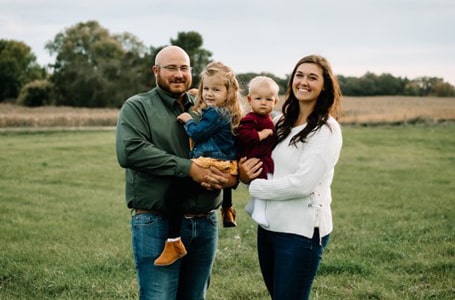
Schmitz Dairy - Cold Spring, Minnesota
Derek and Taylor Schmitz own and operate their farm in central Minnesota, near Cold Spring. Their daughters, Olivia, 3, and Wren, 1, accompany their parents each day on the farm, in training for their future roles as potential dairy farmers. Derek grew up in farming and has worked on farms during his adult life. Starting his own dairy farm operation in 2014, their current farm is located about a mile from where Derek grew up.
Derek and Taylor operate a leased 200-acre farm, all irrigated and all in perennial pastures. They now graze 100% of the land they lease and have no cropping enterprises on their farm. They currently milk 70 lactating cows, have about 20 nanny cows to raise their heifer calves, and develop about 50 heifers annually, selling and raising breeding bulls from their own dairy herd. His target for that enterprise is 10 head or more per year. They have observed positive epigenetic changes in their dairy herd by using their own bulls and these changes have been so positive that other dairy producers are now asking Derek and Taylor for bulls to use as breeding stock. Derek feels that, in a way, they are creating their own breed. In a way, he is correct. He is certainly selecting for epigenetically sound individuals that fit their regenerative production system. To increase diversity in what they do, and in their enterprises, they now have about 30 hair sheep that they purchased in 2021. They also grass finish some steers and heifers from calves that were culled from their breeding stock development program. These are sold directly to consumers. These additional enterprises complement what they are doing with their dairy program and add diversity and revenue to their farm operation.
The Schmitz’s are the only staff on their farm at the present. They have not hired any additional employees to date. It is a testament to how labor-efficient regenerative farming can be that they can operate their dairy while raising breeding stock, grass finishing steers and heifers, raising sheep and direct marketing with just Derek and Taylor’s labor. However, they do see a time coming when they will need to hire additional staff as the farm expands and cash flow dictates.
Their farm lease is a basic annual lease where they pay a per-acre annual rent, plus an additional lease fee for the dairy facility usage. For a relatively young couple getting their start in regenerative dairy farming, this is a great arrangement because it allows Derek and Taylor to minimize capital expenditures and debt. They can focus on developing a financially and regeneratively sound dairy operation, while building a solid business.
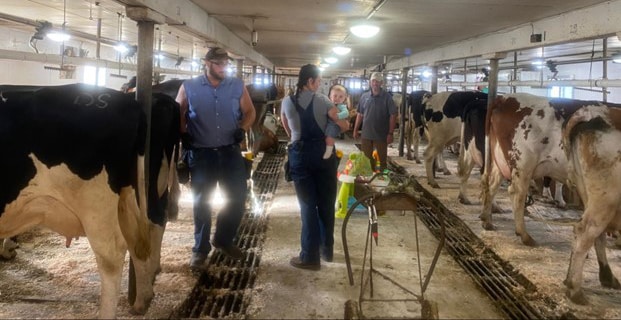
Derek, Taylor, and Olivia in the Milking Parlor
They could extend their lease terms from a year-to-year to a multi-year agreement but have not done this as Derek feels confident in their relationship with the landowner. The land is owned by a family that operated their own dairy farm for several generations and then sold their dairy herd and got out of the business. However, the family still has an affinity for the land and love the way Derek and Taylor are taking care of it. They embrace regenerative principles and practices and want the land operator to be just like Derek and Taylor, lovers of the land and regenerative stewards. The landowners feel very confident in the way the Schmitz’s are progressing toward their regenerative goals.
The landlord’s son, Matthew, runs a small laying hen operation on the land, with 150 laying hens in production now, and 150 more coming up. He plans to direct market the eggs he produces. His enterprise is complementary to what the Schmitz’s are doing as the chickens add yet another layer of diversity, fertility and biological impact. This allows two families to profit from the same acres while building regenerative impact on those acres.
Derek and Taylor do put up some hay from their perennial pastures. While every bale does not always get fed where they were made, they do feed all bales back on pasture to ensure the fertility and carbon from the bales of hay are applied back to the land—in contrast to the majority of dairy farms where the hay and feedstuffs would be fed in a bunk situation in pens or barns. That conventional approach adds an extra level of labor, machinery, fuel and depreciation expense that the Schmitz’s do not have. The Schmitz’s grow about half of the hay they feed and purchase the other half from local farmers. They also purchase the bedding that they use for the cows.
BACKGROUND
Derek’s Dad always grazed his dairy herd, so Derek got a taste of that early on. His dad sold the cows in 2001 and stopped milking, switching to custom grazing dairy heifers using rotational grazing practices. His father still custom raises heifers, but in confinement with the owner supplying the feed. While still in high school, Derek worked part-time for a neighboring conventional dairy farm where he fell in love with cows even more. He had an uncle who was into dairy grazing with 100% grass-fed production and that really appealed to Derek. He says he knew since he was about 15 that grass-based dairying was what he wanted to do.
After graduating from high school, he worked full-time as a herdsman for the same conventional diary where he worked in high school. His experience there proved to Derek that he did not want to be a conventional dairy farmer. In the summer of 2013, after he graduated from high school, the uncle who owned a grass-fed dairy had a stroke. Thankfully, it was not a major stroke and the uncle was absent from the farm for only about a month, but that one-month experience proved to be insightful. “I got to go there and play grass-fed dairy farmer for a month, and I knew that's exactly what I wanted to do,” he said.
In some ways, Derek’s uncle was farming regeneratively. Because he didn't know the principles, he didn't know how to apply everything properly, but in many respects, he was ahead of the game. He didn't use tillage, preferring no-till instead; he didn't feed any grain or use synthetic fertilizers. His herd was certified organic, and Derek knew that was what he wanted also.
After graduating from high school Derek chose not to attend college, choosing another path, selling Fleckvieh semen for Big Bear Genetics. Derek stresses it was not because he was particularly good at sales or even because he liked it. He just wanted to get onto more farms to learn. He sold semen for a couple of years, and it worked out well for him. The job opened ample opportunities for him to visit many farms with a good excuse to ask questions and he gleaned much from those farm visits, including what to do and what not to do in his own operation. This is something that is always encouraged. Take time to visit other farms to glean from them. You always learn something of value, even if it is learning that you do not want to farm similarly. And you will find that most producers will be eager to share their stories.
In the fall of 2013, Derek bought a dozen heifers from a dairy that was doing a good job at operating somewhat regeneratively. The owners of the farm where Derek was working made a corner of the barn available to Derek, so he put in eight stalls. His uncle liquidated his cow herd in the spring of 2014 and Derek bought eight cows from him. He started milking his new cows, switching them out of those eight stalls at that farm. The farm had a few acres (about 8 acres) comprised of small corners of fields that were difficult to access. The farm owners allowed Derek’s cows to graze those corners. That’s how he got his start grazing his dairy herd. Derek grazed acres that the owner thought were too difficult to utilize. Many would have thought the same and missed the opportunity. He says he’s been figuring it out as he goes ever since.
The spring of 2014 was Derek’s first calving season with his new herd. They had their cows on several different leased farms in the first couple of years. One farm they rented for about three years was located about 25 miles north of where they are now. Their landlord used lower inputs, but was a conventional farmer. He grew corn, alfalfa, and other crops for his cows. Derek said that the landlord was laid back to a fault, almost lazy. He felt he had done his time and he didn't want to work anymore so Derek found himself free to do whatever he wanted. This created yet another learning opportunity that he took advantage of.
He then began planting a diverse cover crop mix because he had heard Kent Solberg, of Understanding Ag, talk about how important diversity is. It may have been the year, but his cover crop grew perfectly. He raised some of the greatest feed he has ever grazed and was sold on the value of crop diversity then because it worked out so well. The following year, they grew corn conventionally, both chopped corn and high-moisture corn that was partly fertilized by the fertility applied by the previous year’s grazing impacts.
The next year he was planning to initiate the process of organic certification. Organic markets were aggressively sourcing milk, but that attempt eventually fell through. Derek says he is glad it did because it would have been a tough transition.
He quit growing corn, instead growing barley with hay underneath. He also grew barley followed by a sorghum sudangrass crop. Then they started double cropping with triticale and peas followed by sorghum sudangrass. This was under the guidance of Kent Solberg and his recommendations, which worked well for Derek.
Derek describes that farm as “almost organic by neglect.” The landlord had used a little herbicide on his corn and only some synthetic fertilizer. However, when Derek started adding more diversity, “things really popped.” That experience sold Derek on the importance of diversity. In the three years they were at that location, Derek was able to extend paddock rest periods as he continued to learn, focusing hard on eliminating synthetic fertility and pesticides. Derek anticipated having an opportunity to buy that farm, but it didn't pan out, forcing the Schmitz family to return to the first place they rented. They were still not farming fully regeneratively and were “almost broke” due in large part to low milk prices (about $13/cwt.). It was at that point Derek says, “Things got ugly.”
Since that farm sold their cows, Derek was able to rent 40 acres each of conventionally farmed irrigated and dryland cropland, for a total of 80 acres. They continued double cropping with diverse hay and pasture mixes. Derek decided they should try a higher input approach, a sort of hybrid blend with a Total Mixed Ration (TMR) and grazing. According to Derek, they” almost fell flat on their faces before even starting because the grain bills were $5,000 a month, which wasn’t sustainable.”
The winters of 2017-18 and 2018-19 were especially tough for the family. They spent the summer of 2018 paying for the hay fed the previous winter. Derek recalls that 2018 was an especially dry year, resulting in tight and expensive hay supplies and for which he was paying $320-$340 per ton for the hay he was feeding. They didn’t have any corn silage at the time but were feeding high-moisture corn and buying supplemental protein. Derek decided that winter that they couldn’t continue down that path and that “something had to change.”
They cut fed corn down to about six pounds per cow, per day, and eliminated purchased protein, allowing the protein from the hay to suffice. They also started culling cows. Derek said, “If a cow looked at me wrong or if she didn't flourish on what we gave her for feed, she just had to go.” In those next couple of months, Derek downsized by 30-40%, (from 78 to about 50 cows). As tough, painful and scary as it was, Derek sees now that it was the best move they could have made. What he did not realize at the time was that he was making epigenetic selections that would prove quite valuable going into the future. By culling as he did, Derek was selecting for epigenetics that were highly efficient and low maintenance.
The following summer, they focused on improved pasture management. The smaller herd size was a much better fit for his pastures. They also decided to give up the lease on the dryland cropland they were renting and purchased supplemental feed instead. Derek feels they could have turned that farm around with time, but he wasn’t sure his checkbook was deep enough because “That land was so farmed out and tired.” For example, when he would provide enough fertility inputs, the alfalfa he was growing would produce good yields and it tested fine from a typical nutritional test standpoint. However, it simply did not feed well and the cows did not do as well as the test results indicated they should. Derek stated the alfalfa would just “fly through the cows.” So, he bought other types of hay, which worked fine. Their landlord was farming quite a bit of land in the area so they bought their supplemental feed from him.
In 2020, they ended up relocating to the farm they are currently leasing. Derek finds this farm very interesting because the landlord has been soil health-minded since the 1970s when they started doing ridge till. They've been monitoring brix levels in their crops since then. Derek believes crop diversity was one key thing lacking on this farm, so they have taken steps in recent years to increase diversity. However, livestock integration (a key soil health principle) was absent. Their landlord and his family operated their dairy (when they were dairy farming) conventionally. When Derek leased the farm, he and Taylor immediately put their cows out on pasture and grass production increased dramatically. This animal impact triggered more grass and more feed available to the cows.
The landlord’s oldest son happened to attend a Soil Health Academy in the fall of 2019. He came home and started planting more diverse cover crops. In the spring of 2020, Derek also attended a Soil Health Academy. Upon his return to the farm, he was invigorated with this new knowledge and started implementing what he had learned much more aggressively. The academy and the new network of supporting regenerative farmers and from Understanding Ag allowed Derek to gain the confidence to increase his rest periods after each grazing event. This was a major game changer, according to Derek, because it resulted in even more forage biomass growth, higher plant brix levels, and greater plant species diversity.
About that time, Derek met Doug Voss, another Understanding Ag consultant. By asking the right questions that force producers to recognize their shortcomings, Doug pushed Derek to extend the paddock rest periods even more and to make the full transition to more regenerative production practices.
The first year Derek was at his newly leased farm near Cold Spring, MN, he had about 50 cows, including the nanny cows, and 20 developing heifers. He and Taylor grazed the cows for most of that growing season and put up about 380 bales of hay and baleage.
In the summer of 2021, Derek and Taylor fed about 65 cows and also put up 380 bales of hay. In the summer of 2022, they fed 80 cows, plus 50-60 heifers and grass-finished several steers. He has also taken on some custom cattle and a dozen custom heifers each year. Even with the additional animals grazing, they produced another 380 bales of hay with the individual bales being heavier than before. Derek estimates that they have doubled their forage production in the last three years and commented, going into the winter of 2022, “I have as much grass in front of me as I've ever had going into winter. Snow will stop us before we run out of grass.”
It is important to note here that in just three grazing seasons, the stocking rate on the same acres more than doubled, compared to his starting stocking rate. At the same time, the hay production from those same acres was maintained at a consistent level. This would support Derek’s assertion that he has been able to double his forage dry matter biomass production during the span of three active grazing seasons. This was accomplished without purchasing synthetic fertilizer. Instead, fertility is now being applied through the grazing animals.
Derek and Taylor took a note from Gabe Brown, who waters his cows during the winter off the snow (just like the wild ruminants have done for eons), and who winters his heifers out in the pastures, allowing the cattle to dig through the snow to find their forage. This worked quite well for Derek and Taylor, and the heifers performed splendidly, while their health was better than ever before. Once again, Derek was using epigenetic selection to further build a genetically sound cow herd that fits his environment to a tee.
By implementing outwintering strategies, Derek has extended the grazing season by 100 days. He estimates his dry cows and replacement heifers grazed the winter of 2021-22 with no supplement for $0.61 per day.
Key benefits realized from out wintering included:
- A cost per head per day of $0.61 compared to neighboring dairies costs of $4.00/hd/day.
- No other supplement costs besides salt.
- No pen cleaning.
- No daily TMR mixing and feeding.
- No need to crank a tractor or feed truck daily. Just simply move a temporary fence.
- No waste management issues.
- Cattle were very healthy and the outwintering produces positive epigenetic effects.
- Saved at least $300/week in labor and fuel costs.
- Saved depreciation on equipment.
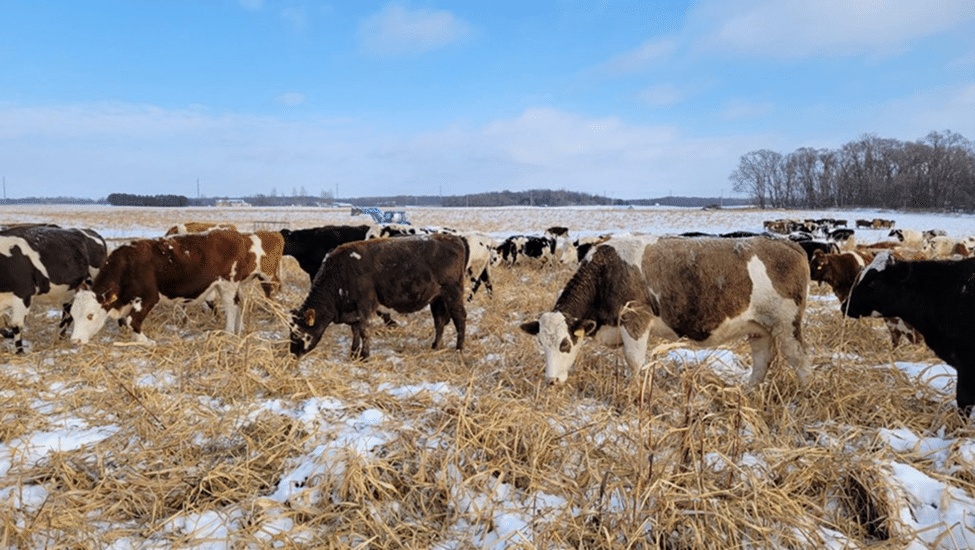
Heifers and Dry Cows Grazing Winter Stockpile
With his milk cows (lactating cows), production drops quickly if they must forage more than a few inches below the surface of the snow. However, if the snow is soft, they can go up to a foot with no problem and get the nutrition they need. Derek and Taylor monitor intake of the cows closely, limiting stockpiled forage to about 25% of their daily intake; otherwise, milk yields plummet.
His heifers grazed cover crops through most of January 2022. Derek said he started managing his diary replacement heifers more like beef cattle after Kent Solberg, Understanding Ag, recommended to him that dairy farmers should be paying attention to what beef farmers are doing—and that there is no reason that dairy replacement heifers and dry cows can’t be managed similarly to beef cattle in their grazing. This is antithetical to what the majority of dairy farmers have been taught and believe, which is dairy heifers and dry cows need nutrition superior to what their beef cattle equivalents would need. Derek agrees with Kent that plenty of cost savings can be accrued by taking a page out of what beef cattle regenerative grazers are doing. He also reports far-improved epigenetic benefits in his herd.
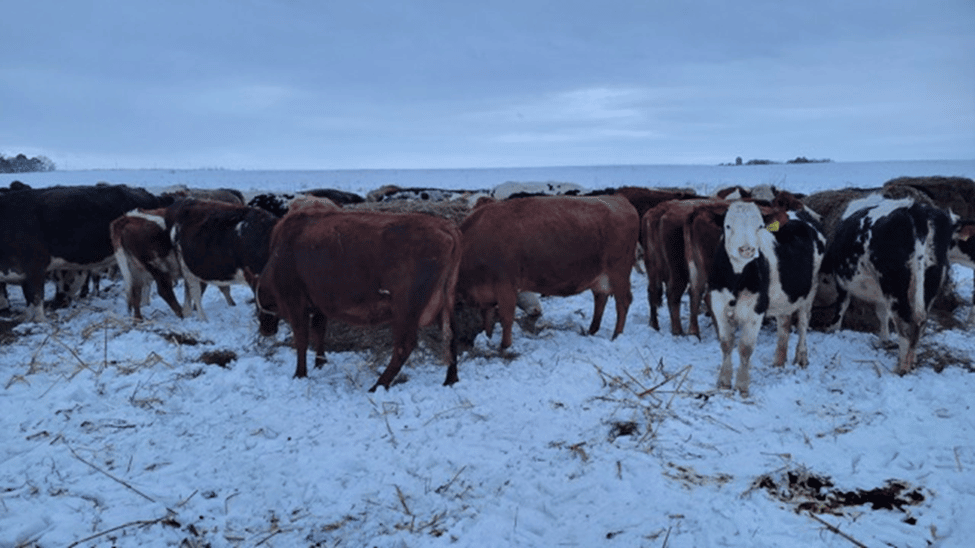
Bale Grazing Heifers and Dry Cows in the Winter
In addition to Kent’s recommendation, Derek mentioned reading a study from several years ago in which Dr. Fred Provenza (Understanding Ag Board of Advisors) and Randy Weiderman split a group of dry beef cows in their last trimester of pregnancy and fed one group low-quality feed, while feeding the other group high-quality feed. The resultant calves from the group fed low-quality feed performed better with higher body condition scores, among other traits, over their lifetimes than the calves from cows fed the high-quality feed. This trial is featured in Fred Provenza’s book, Nourishment.
Derek has been managing his replacement heifers and dry cows in a similar manner for the last several years and it has worked well.
More recently, Derek and Taylor moved from a twice-a-day to once-a-day milking on their late-lactation cows. Those cows are in better body condition at dry off, even with lower-quality supplemental feed and some salt. They are in excellent body condition when they calve and start their next lactation with very acceptable milk and milk-component production. Additionally, they have not experienced a retained placenta in years.
Five years ago, Derek and Taylor began using nanny cows to raise their replacement heifer calves. Most dairy farmers take their heifer calves off the birth cows within 2-3 days after birth and raise those calves on a powdered milk and feedstuff ration. This creates an artificial environment and diet for the calves and epigenetics suffer as a result. The switch to raising calves on nanny cows and a natural diet has resulted in superior epigenetics and lifetime performance. The evidence to date indicates that the heifer calves raised this way will have significantly longer lifetime lactations, their health status and reproductive performance will be better, and they fit their environment much better with far fewer inputs required. They are capturing significant positive epigenetic benefits and these benefits are transgenerational so future progeny will be even more improved.
Derek has developed a system that seems to work well with the nanny cow raising of the replacement heifers. He puts two heifer calves on one nanny cow, and maintains that ratio of 2:1 throughout. He started by keeping the heifer calves on the nanny cows for about 6-7 months before weaning, but has now extended that to nine months of age before weaning. That extra 2-3 months on the nanny cow makes a huge difference in the development of the heifer and in her epigenetics. The calves learn much more from the nanny cows in that period of time and are very easy to handle from that point forward. It also makes a difference in the lifetime grazing habits of the heifers, and in their lifetime health status. Allowing that extra degree of maturity to occur before weaning the heifers pays dividends well into the future. The nanny cows are sourced directly from Derek’s herd, by using the high somatic cell count cows, cows with udder problems, or less than desirable attitudes, as the nanny cows. Derek refers to this as a “midlife career change” for the cows that he transitions into nanny cows.

Heifer Calves on Nanny Cows
Derek and Taylor started using nanny cows when they were significantly culling their cow herd. Taylor had taken a job off the farm and Derek was having to bottle raise the calves in a pen near the tie stalls where the cows were milked. He had two high-somatic cows who always went and stood by the calves to be milked. Derek would milk the cows into a bucket and then turn around and dump the milk into the calves’ feeder to group feed the calves. He realized that it made no sense to go through that extra step and labor. They started putting calves on those cows and they’ve been doing it ever since. A small step has saved many hours of labor, input costs, and has resulted in epigenetically sound replacement females. The labor savings alone amount to a minimum of one hour per day. Derek no longer spends money on milk replacer and feedstuffs for the developing heifers. He does not have to buy bedding and clean pens and the heifer calves are far healthier and do not require the medical care that they once did. The savings per heifer in development costs from just this alone amount to more than $300/calf. It is harder to put a specific number on greater lifetime lactations, enhanced reproduction, and better overall health, but it does add up over the lifetime of the individual cow.
Early on, they didn’t use fresh cows as nannies so they had to spend a couple of weeks with the cow and calves in a pen together getting the nanny cows to accept the calves. Now they start them on fresh cows and they run them with the dairy herd. They have 25 calves with their nannies out grazing with the cow herd. It’s a management strategy that saves Derek much time and dollars.
Derek turned to a low-input farmer that Kent Solberg connected him with for guidance. This farmer’s personal rule was that he wouldn't spend a dollar unless it would make him at least $5 in return. Part of the low-input farmer’s land had been a gravel pit that hadn’t been closed properly. Just by grazing, he closed off the pit and he started growing grass on it. He grew more and more feed every year and was milking 30 to 40 cows with a total annual per cow cost of about $5,000 for feed, bedding, diesel, twine, etc., using older equipment.
This operator had farmed that way since 2007 and it worked well for him. Derek learned much from him and patterned his operations after this farmer’s practices. In the winter of 2021, he liquidated his cow herd and Derek purchased them. Those cows were raised as low-input cows, which were exactly the type Derek knew he wanted. By continuing to select replacements from these cows, Derek is moving closer to the herd he has envisioned for years.
THE TRANSITION TO REGENERATIVE AGRICULTURE
Derek readily admits he didn't really know what he was doing when he first started grass-based dairying. But he likes to read, and he was reading everything he could find on the topic. That’s when he came across Kent Solberg of Understanding Ag. Kent gave Derek contact information for several grass-based dairy farmers and Derek visited them to educate himself.
Derek continued to learn and visited many farms, much as he did while selling semen. He was learning more from other farmers and spending a lot of time reading. Looking back, Derek realizes that he was already providing longer rest periods after grazing events than most dairy farmers. He attributes that to the disparity between what he was observing with his grass production and the prevailing dairy grazing mentality which is influenced by the New Zealand-based approach with 20–25-day grazing periods.
Derek could never keep up with the grass in the spring, and he could never see leaving more behind and was clipping more to maintain that 20-25 day rotation. Instead, he ran longer rotations and saw that it worked well. His cows still produced, he never saw milk yields drop while grazing more mature grass. He started to believe that longer rest periods could work, but he never stretched those out to 60-, 70-, or 80-day rotations. He was still in the 30-40 day rest period foremost of his rotations.
Derek can’t peg a specific point in time where he thought, “I’m going to produce regeneratively now.” He sees now that he was using some regenerative practices before he even knew what he was doing.
One reason motivating him to move towards low-input production, which opened the door to regenerative production, was what he had observed with his dad. His dad simply burned out. He was milking 65 cows in a tie-stall barn, wheeling in all the feed to them, taking all the waste out, and doing all the fieldwork. Derek knew he had to do things smarter rather than just thinking that hard work alone was enough. He had to become a “thinking” dairy farmer.
Plant diversity in Derek’s perennial pastures is steadily increasing. He now has more than 30 different species in most of his pastures, with the majority of these species volunteering from the latent seed bank in the soil. Derek did not have to spend money on renovating pastures or buying seed. He let his cows, through his adaptive grazing practices, do this job for him. Derek is confident that he has nearly 100 different plant species in some of his perennial pastures now.
By using his cows and adaptive grazing strategies, Derek is realizing significant cost savings over renovating pastures. The true cost for pasture renovation—including pasture preparation for the new seeding, seed purchase costs, seeding costs, fertilizer and herbicide costs, and time that the renovated pasture could not be grazed—usually exceeds $500/acre. In contrast, Derek did not miss any grazing time, purchased little seed, spent very little on overseeding, and nothing on added fertility and herbicides.
When he plants cover crop mixes for annuals’ production, he usually uses a blend of 15-20 different plant species in the mix. For shorter-term small grain mixes, he may use a blend of 6-7 species.
They do not use any tillage practices now due to the heavy use of perennials in their pastures. Annuals are seeded using no-till drills. They don’t use any synthetic chemicals, no herbicides, fungicides, or insecticides. They also do not use any synthetic fertilizers. The only fertility applications are from composted manure from the yards and buildings, which primarily goes on the ground used to make hay.
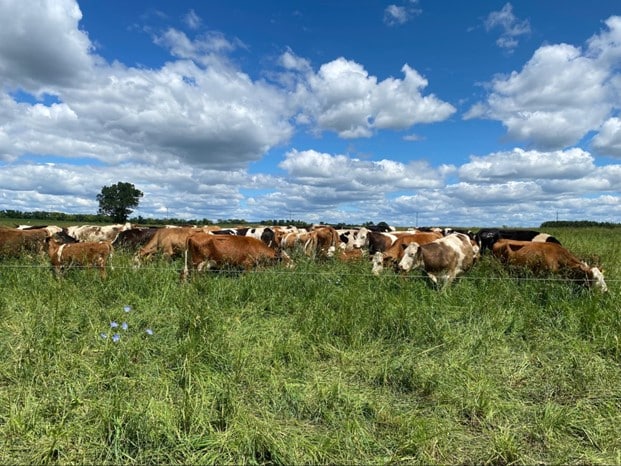
Cows Grazing Diverse Perennial Pasture
They never harvest hay on the same field more than once a year. Where they make hay and where they start and finish grazing varies from year to year. These are basic tenets of what is taught by Understanding Ag and the Soil Health Academy. Derek and Taylor strive to be non-prescriptive in their practices and to instead use adaptive principles. They graze their individual pastures from 2-4 times a year, depending on the rest periods Derek thinks they need. The rest periods are a minimum of 45 days, with most getting a 70-day rest between grazing events. He is now seeking to stretch rest periods out to 90-100 days, at least periodically. Specifically, Derek uses adaptive grazing principles taught in the Soil Health Academy by following the Rule of Disruption (Fact Sheets).
Derek and Taylor have now hosted a Dairy-focused Soil Health Academy and a handful of other regenerative workshops. They are hosting their second Soil Health Academy in June of 2023. The farm was also featured in a short documentary made specifically for General Mills.
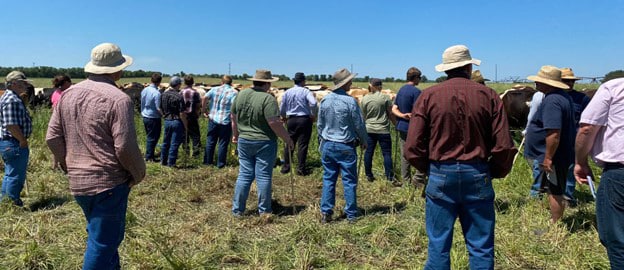
The 2021 Soil Health Academy Class Hosted by Derek and Taylor
KEY CHALLENGES AND PROBLEMS
A key challenge Derek reports facing centers on purchasing replacement cows from other dairy herds. Because most dairy farmers are more conventional in their approach, their cows simply do not work well for a regenerative operation. As more dairy farmers adopt regenerative principles, there will be a need for sound dairy genetics and epigenetics. Derek expects his cows to be well-adapted because of his nanny cow system and because of his cows' lifetimes of grazing. Earlier on, Derek experienced issues with his cows grazing some of the time and feeding at other times. These cows were not able to adjust well to one system or the other and it impacted their epigenetics. He sees now that they should have just sent the entire herd to market since cull cows were $1.00 per pound at that time and wishes he had gone with Jersey cross cows and Fleckvieh bulls at that point. Similarly, back when Derek expected to operate with higher inputs and feeding a TMR, he bought cows from an existing herd, expecting the cows to be able to transition to grazing. But they did not. Derek says those cows just flopped; some just would not eat grass. Of the 29 cows they bought, they ended up selling 27 and only one remains in the herd. Those were some expensive lessons that Derek does not want to repeat.
Derek also wishes he had gained a better understanding about soil health and biology earlier. His uncle who had the grazing herd gave him a subscription to Graze magazine as a high school graduation present in 2012. He says he would skip the articles where Dr. Allen Williams wrote about soil health, thinking they were boring. It wasn’t until 2014 or 2015, when he was working as a herdsman on a neighboring dairy, that he realized how important soil health really was.
To feed his own cows, Derek had the option to buy feed from the dairy he worked for, or he could buy from his dad. He observed that while feed from his dad would technically test lower, his cows strongly preferred it. They would leave the other hay in the feeder and eat all the hay that he had bought from his dad. Derek realized the connection, that his dad did a good job with his soil, he didn’t use much synthetic fertility, he had diversity in his hay fields, and the only fertility was manure and a little bit of ammonium sulfate. That’s when it clicked for him and then he began reading Allen's articles with great interest.
Derek recalls reading one article in particular in which Allen mentioned the importance of bringing a shovel into the field. He had never brought a shovel to the pasture before, but he started bringing one then, digging holes and counting worms, trying to figure out what was going on. It was a learning process and his visit to Doug Voss’s farm was very helpful because it provided real-world context.
Derek’s cow herd genetics were still a problem at that point, but he has steadily been addressing that since through his culling program.
Marketing is an ongoing problem. Although he sells some raw milk and grass-fed beef directly to consumers, Derek sells most of his milk to a conventional market. He says they’re not making any big marketing changes yet, but a couple of his farming colleagues are working on ideas for more direct marketing of their milk and dairy products. They are looking into the potential of becoming regenerative certified through the Regenified program.
SUCCESSES
Derek points first to the costs of production, which he estimates that they’ve slashed by about 75 percent, as the biggest regenerative success. The milk he produces is of higher quality, with higher protein and butterfat content, and somatic cell counts are lower. He earns milk quality awards annually.
Derek used to have an 80-pound per-cow tank average, which is considered good for a less-than-conventional dairy herd. However, due to input costs, he was going broke. Now he reports a 27-pound per-cow tank average. He said that he is reluctant to share his individual cow production averages, not because he is ashamed of it, but because he doesn’t want to scare conventional dairy producers away. He thinks they certainly struggle to understand how he could be making a living on cows milking 8,500 to 9,000 lbs. per year. But, he’s milking once a day, the cows are on grass, requiring little baleage, and Derek has much more control of his time. Importantly, he is no longer going broke.
With the switch to grazing and once per day milking, Derek estimates a savings of $1000 per month in electricity and supplies. When he adds in labor costs, his savings exceed $3000 per month. Labor requirements have decreased close to 50% on a daily basis.
It now costs about 30% less per hundredweight to produce milk. When this is combined with a 70% first service conception rate with his cows, he has an excess of females available as potential replacements. This will allow for future expansion in numbers of lactating cows and for establishing satellite farms.
Quite interestingly, Derek was averaging 80 lbs of milk per cow per day managing more conventionally. When he transitioned to grass-based production, more moderate cow genetics, and once-per-day milking, his production per cow dropped to 30 lbs/milk/cow/day as an average throughout the entire lactation. To many that would appear to be a disaster, losing 50 lbs of milk production per cow per day. The disaster was Derek was not making any money at the high production level. His costs to make that extra 50 lbs/cow/day exceeded the value of that production. By going in the opposite direction, Derek achieved net profitability and much higher quality of life.
Their veterinary health costs are less than $5 per cow per year, down 90 percent compared to what they were prior. He reports a first-service conception rate of over 70% in his herd. They no longer vaccinate cows, pregnancy check, use antibiotics or dry treat using intramammary mastitis treatments. Dystocia problems are down to almost zero; Derek reports only 1% of his herd has required assistance with calving in the last five years. Morbidity and mortality of his young stock have also approached zero since transitioning to regenerative production.
Their feed costs are down 75 percent and they have more flexibility with their heifers, including the option to sell more or keep and raise more to facilitate herd expansion. Their cull rate is down to under half what it was, from 40% to only 15%. Derek also reports interest in his herd genetics, creating opportunities to sell breeding stock to other farmers in the form of bulls and replacement heifers. Another cost savings that is difficult to quantify, since they haven’t been doing it long enough yet, is once-a-day milking year-round. Derek made the move in response to workload and labor issues at the time.
He says there are other benefits they expect to accrue, but haven’t seen yet, including about 15% savings in dry-cow costs because cows are in better condition, resulting in improved reproductive efficiency. Derek says their reproductive efficiency has always been at least satisfactory, but is improved further when they went to low-input production. With the shift to once-a-day milking, first service conception was above 75% in 2022. In most conventional dairies this number is in the 25-35% range.
The once-a-day milking strategy opens opportunities for Derek to grow his operation because he can grow more grass. Financially, he realizes that he should be buying more hay rather than putting it up himself, but admits he is reluctant to give up that control. He estimates it costs about $160 per ton to raise his own hay, and in a year like 2022, he could buy all the hay he wanted for less than $160 per ton. Plus, he wouldn’t have to make the hay on his farm so he wouldn’t have to degrade resources on his farm. Still, he likes knowing his feed costs are not going to be adversely affected by unforeseen market price increases.
Since Derek is grazing all perennials now, they're not spending nearly as much on seed every year. He and Taylor were discussing the farm recently and they realized that while they are still “cash poor,” they see the transition occurring. Their genetics aren't where they want them to be just yet, even though they have improved significantly. The once-a-day milking is still a work in progress, but they are no longer “grass poor” anymore. The one thing that worries a dairy farmer more than anything else is not having enough feed for the year. Derek said, “Sure the checkbook’s slim, but there are no big bills hanging over our heads and we have plenty of grass. So, for me, that's been the coolest thing in the last probably a year and a half.”
Derek also reports making progress towards retiring farm debt. Previously, he just kept enough heifers to replace the cows he culls, but recently he has borrowed more money to expand his herd. He thinks he may grow organically more in the future by retaining more heifers because epigenetic gains are too important.
Derek estimates that it costs him about $1,700 per head for spring-born heifers to raise them to bred two-year olds. Fall-born heifers cost about $2,000. That’s about $500 per heifer less than what Derek estimates it cost him prior to his shift to regenerative agriculture. In contrast, conventionally raised heifers cost from $2,700-$3,000 per head to develop. A key to Derek’s low-heifer-development cost is using nanny cows, with two heifers per cow. Derek also grazes as much of the year as possible with everything together, cows, replacement heifers, and nanny cows. He can sort cattle in a holding pen much more quickly than grazing separate groups. He also grazes at higher-stocking densities and gets longer rest periods with much less fencing required. One huge benefit they’ve seen is how the heifers learn from older cows.
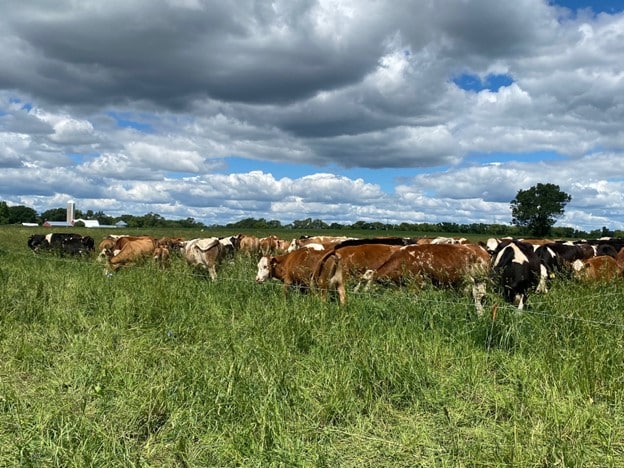
Having Enough Grass is No Longer a Problem
Derek’s longer-term goal is to expand his operation to 120 cows and then start a satellite farm. That would position them to grow to the point that, every couple of years, they could replenish the farm.
Derek’s start in the dairy business was tough and he wants to help others move up the learning curve more quickly than he did. He thinks that had he started with good cows and a better sense of direction, he would have progressed more rapidly. He wants to help others get going in the right direction sooner. Sterns County, MN, Derek’s county, is the number one dairy county in Minnesota. Historically, nearly all farms were dairies, but now they are fewer and farther between. Derek dreams of converting some of these farms back to dairy production, using regenerative principles to support them as grass-based operations. Derek’s vision includes getting young apprentice farmers working as herdsmen for him for a few years, then with his assistance, helping them get started with a good herd and a clear vision. While details about financing the new herds and helping them get established need to be fleshed out, Derek is passionate about helping.
Other successes Derek reports include observing some plant species return from the latent seed bank including big bluestem, woodland sunflower, Maximilian sunflower and compass plant. He’s hoping to see more as he extends paddock rest periods.
Beneficial insect, pollinator, bird life and other wildlife populations have exploded on the farm. The farm features six watering points and two towable irrigators. Birds line the entire 500’ length of the irrigator and Derek says there are deer in the fields now, which is something that he didn’t see when it was farmed conventionally. In the fall of 2021, there were at least 40 pheasants in a five-acre cover crop field where heifers were grazing. After two eagles arrived, the pheasants disappeared either through predation or migration. Although there's a lake about a mile from the farm, Derek has observed mallards nesting in the pastures.
With Derek now allowing for longer rest periods between grazing events and the plant species becoming more mature and erect, Derek is seeing Red Winged Blackbird nests and cowbird nests in his fields, too. The fields are just loaded with nests, he says. Derek saw a meadowlark recently, which his landlord says he hasn’t seen since he was a kid walking to school years ago.
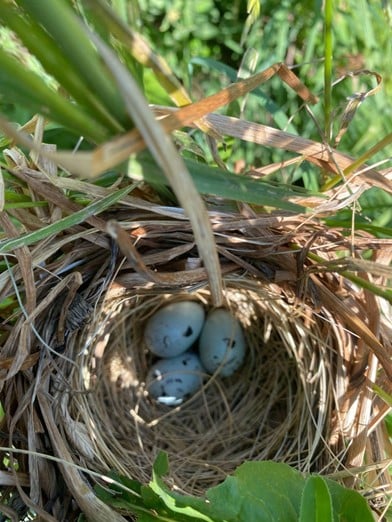
Redwing Blackbird Nest in Derek’s Pasture
The rebounding birdlife suggests that the insect life has exploded too. Derek noted a dramatic increase in observed bee activity.
They used to have trouble controlling foxtail grass, but recently they have observed more crickets, which eat foxtail seeds, so the foxtail pressure has diminished.
Although Derek does not have recent measurements to show changes in soil organic matter or other soil changes since he has been at this location, he does have benchmark data from when he started, funded in part by a grant from Kiss the Ground.
When asked about his neighbors’ and family’s reaction to his move to regenerative agriculture, Derek says many of neighbors think he’s nuts for making the move. While it used to bother him, feeling the need to explain himself all the time, he doesn’t care anymore. In fact, he derives great joy out of “weirding them out.”
Some neighbors are starting to ask questions about cover crops and grazing, etc. One neighbor might have some Kernza that Derek may get the chance to graze. Kernza is a perennial intermediate wheatgrass developed at the Land Institute in Salina, Kansas, with improved varieties under development at the University of Minnesota. In 2023, if neighboring farms plant canning crops, they'll plant a cover crop following, which he may also have the opportunity to graze.
As far as family response goes, he says, “Some of them get it, some of them don't.” It took Derek eight years to convince his dad about the benefits of transitioning to regenerative agriculture. Recently, he got his dad to join him in the pasture. Derek says he was just playing dumb, telling his dad he had had some steers to check to make sure they were finished. His dad’s philosophy has always been “just a couple of pounds of grain goes so far.” But when his dad realized that these cows that looked so good to his experienced eye hadn’t eaten any grain, he was amazed.
Derek described the progression of the breed makeup of his herd. They started with all kinds of crosses, the heifers he bought were Holstein and Normandy crosses. The cows Derek bought from his uncle were Jersey crosses. He had started breeding Fleckvieh and has been breeding exclusively Fleckvieh for 5-7 years. He also bought some purebred or near purebred (7/8 or ¾) Fleckvieh cows. But they were too large and too late maturing. Many of his heifers weren’t mature enough to breed until they were 18 months old, which doesn't work for a seasonal herd. Of these cows, Derek says, “It seemed that the bigger cows were, the dumber they were, too.” So they started selecting different breeds including more polled breeds and Kiwi cross bulls with New Zealand genetics.
Derek liked the Jersey cows that were bred to Fleckvieh bulls, which he describes as “really good cows.” They also started breeding New Zealand Jerseys. They’ve also used some Norwegian Red and a little bit of Normandy, but he says they never really worked out that well in his system. According to Derek, the Norwegian Reds have their role, but he says, “I almost went too far with them, ending up with cows a bit too small.”
Derek’s target is an 1100-pound cow with a blend of Jersey, Fleckvieh, and some Norwegian Red. In 2022, they were quite intentional with their bull selection, using Jersey-sired bulls from their herd. He also used AI to breed some cows to Fleckvieh bulls and New Zealand Kiwi cross bulls. The herd is mostly polled. Derek plans to do some AI in 2023, but then he plans to strictly use bulls he raises.
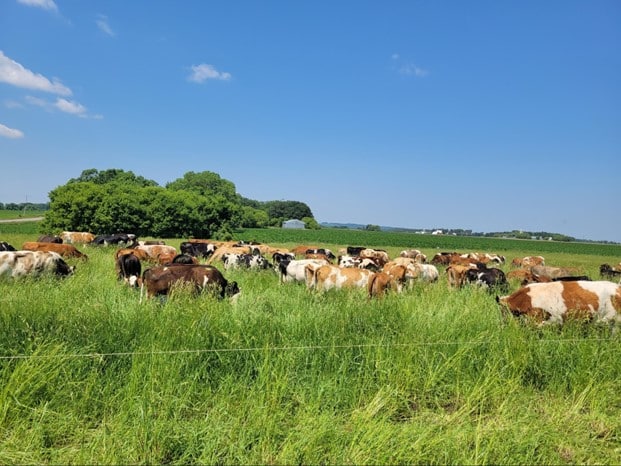
The Current Genetic Mix
One thing that Derek knows now that he wishes he had learned earlier, is the importance of buying animals adapted to his grazing strategies. Another is using longer paddock rest periods, which he feels would have helped boost hay quality. “I wish I would have ripped the Band-Aid off sooner,” he says.
Derek believes he is observant with his pastures and his cattle, that he can see through a cow and figure out what's going on. He wishes he had been more purposeful with his education sooner, like attending Soil Health Academies. He attended local pasture walks and events like that, but he says they didn’t always offer what he was after. Finding like-minded peers earlier on would also have been very useful, he says, and he has helped form a regenerative grazing group to provide a community where he and others can help each other learn and grow.
There are plenty of grazing dairy farms nearby, but Derek recognizes there is little he can learn from them, unless he wants to learn to cultivate corn. The cows are grazing 30-40% of their grass out on pasture. They’re fed 25 pounds of corn silage, 10 pounds of corn in the barn, and straight alfalfa. At their grazing meetings, he says, it’s the same topics. “They whine about how their grass plays out, about how it hasn't rained; then they talk about the new mower or plow they bought. Then they go talk about corn the rest of the time. Nobody challenges each other or bounces ideas off each other. The purpose of the regenerative grazing group is to provide that,” he says.
Derek recommends that those considering a move from conventional to regenerative production get educated. He says attending a Soil Health Academy is a must. He adds, “Visit others’ regenerative farms. Read everything you can find and watch videos. And don’t be afraid of trying something new. Even if it’s a small experiment on just a part of the farm, it will provide a benchmark for comparison.” Derek says he recalls reading that the average Fortune 500 company spends 4% of their total gross income on research and development. “If a farm would do that,” he says, “that would be something.”
Derek says things have begun to ease financially, and that sometimes there's still money left at the end of the month after they get their milk checks. That's a big step. He’s been told that it’s a basic rule to expect 10 years of hell before you really get your feet underneath you. However, he says that if he was farming conventionally, he would have been broke years ago. And had he survived somehow, there would be no escape from the debt load. A dairy farmer of similar size to Derek, has almost $2 million in debt. “There's no light at the end of that tunnel milking 70 cows, he can't dig himself out of that,” he says.
One other important aspect of Derek’s approach to farming is that the only piece of equipment he owns is a loader tractor. The farm is that simplified. Everything is custom harvested. Manure is custom hauled and spread. Seeding is custom done. “It makes me honest with my numbers because I get the bills,” he says.
